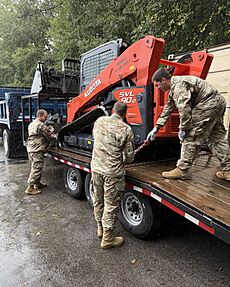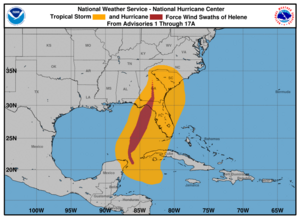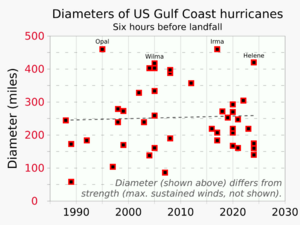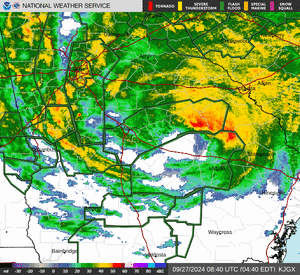Hurricane Helene facts for kids
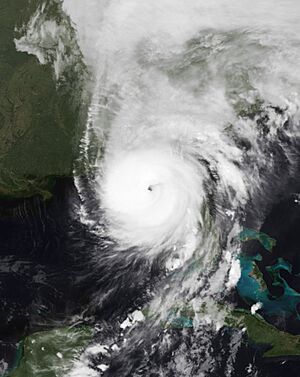
Helene at peak intensity just prior to landfall in the Big Bend region of Florida late on September 26
|
|
| Meteorological history | |
|---|---|
| Formed | September 24, 2024 |
| Extratropical | September 27, 2024 |
| Dissipated | September 29, 2024 |
| Category 4 tropical cyclone | |
| 1-minute sustained (SSHWS/NWS) | |
| Highest winds | 140 mph (220 km/h) |
| Lowest pressure | 938 mbar (hPa); 27.70 inHg |
| Overall effects | |
| Fatalities | ≥113 |
| Missing | ≥1,073 |
| Damage | ≥$20 billion (2024 USD) |
| Areas affected | Yucatán Peninsula, Honduras, Cayman Islands, Cuba, Southeastern United States (especially Florida, the Carolinas and Georgia, but also including Alabama, Tennessee, Kentucky, Virginia and West Virginia), Midwestern United States (Illinois, Indiana, Ohio) |
|
Part of the 2024 Atlantic hurricane season |
|
Hurricane Helene (pronounced hehl-EEN) was a very strong and fast-moving hurricane. It was the strongest hurricane ever to hit the Big Bend region of Florida. Helene was the eighth named storm and the second major hurricane of the 2024 Atlantic hurricane season.
The storm started as a large area of low pressure in the Western Caribbean Sea. The National Hurricane Center (NHC) began watching it on September 17. By September 24, it became a tropical storm and was named Helene. It was near the Yucatán Peninsula. Helene quickly grew stronger as it moved into the Gulf of Mexico. On September 26, it became a Category 4 hurricane.
Late on September 26, Helene hit Florida near Perry. Its winds were 140 mph (220 km/h). Helene quickly weakened as it moved over land. It became a post-tropical storm over Tennessee on September 27. The storm then stayed over Tennessee for a while before disappearing on September 29.
Before Helene hit, Florida and Georgia declared states of emergency. This was because of the expected high storm surge and strong winds. Helene also caused huge floods, especially in western North Carolina and eastern Tennessee. As of September 29, at least 113 people died because of Helene. More than 1,073 people were also reported missing.
Contents
How Hurricane Helene Formed and Grew
On September 17, the National Hurricane Center (NHC) began looking for a storm in the western Caribbean Sea. Conditions were good for a tropical cyclone to form. This was due to a large low-pressure system called the Central American gyre. It worked with the Madden–Julian Oscillation to create strong winds.
By September 22, a wide area of low pressure formed in the western Caribbean. Showers and thunderstorms slowly came together. Because the system was a threat to land, it was called Potential Tropical Cyclone Nine on September 23. The next day, planes from the Air Force Reserve Hurricane Hunters found stronger winds. The NHC then upgraded it to Tropical Storm Helene. This happened at 3:00 PM UTC on September 24.
Helene kept getting stronger. By 3:00 PM UTC on September 25, it became a hurricane. It was starting to move into the Gulf of Mexico. A weather system to its west and a high-pressure area to its east guided the hurricane towards the U.S. Gulf Coast. Helene was a very large storm. The NHC noted it was among the largest hurricanes of its kind.

Helene stayed at a steady strength for a while. This was because of its large size and some dry air. But early on September 26, Helene began to get much stronger very quickly. This was helped by low wind shear, high humidity, and warm ocean waters. A clear eye formed. It became a Category 2 hurricane at 12:00 PM UTC.
It strengthened fast. By 6:25 PM UTC, Hurricane Hunters found it was a major hurricane. Four hours later, it became a Category 4 hurricane. Helene reached its strongest point later that night. It had winds of 140 mph (220 km/h) and a pressure of 938 mbar. This happened at 3:10 AM UTC on September 27. It hit land east of the Aucilla River, near Perry, Florida. It was the strongest hurricane to hit Florida's Big Bend area.
The storm quickly weakened as it moved inland. By 5:00 AM UTC the next day, it was a Category 2 hurricane over Georgia. A few hours later, it weakened into a tropical storm over east-central Georgia.
Getting Ready for Hurricane Helene
Many areas prepared for Hurricane Helene. People were told to evacuate, and schools and businesses closed.
Mexico's Preparations
Tropical storm warnings were put in place for the eastern Yucatán Peninsula on September 24. Parts of Quintana Roo and Yucatán were first on a blue alert, meaning indirect impacts. This was later raised to a red alert, meaning maximum danger. Cruise ships canceled arrivals on September 24 and 25. The Tren Maya train also closed. On Isla Mujeres, two shelters opened. People in dangerous areas were moved to safety. Visitors on Isla Holbox could take a free ferry off the island. Schools in Quintana Roo were closed.
Caribbean Islands Get Ready
Cayman Islands
The Cayman Islands got a tropical storm warning on September 24. The Red Cross shelter opened, but no one used it. Sandbagging sites opened on Grand Cayman and Cayman Brac. Schools closed on September 23 because of heavy rain. Charles Kirkconnell International Airport and Owen Roberts International Airport closed. The Cayman Islands Regiment helped prepare and give out sandbags. A small craft warning was issued for boats. The tropical storm warning was canceled the next day.
Cuba
Western Cuba received tropical storm warnings and hurricane watches. Medical teams were ready for flood-prone areas. Schools and ports closed as heavy rain started. Fishing boats were called back to shore. Ferry services in Regla were stopped. The Maritime Administration of Cuba also stopped navigation in the Gulf of Batabanó.
United States Preparations
Amtrak changed or canceled some train routes in the southeastern U.S. between September 27 and 28.
Florida

Hurricane warnings were issued for Florida's Big Bend Coast. Most of Florida, except the far western panhandle, was under a tropical storm warning. On September 26, an extreme wind warning was issued for the eastern Florida Panhandle. This was the first since Hurricane Idalia. On September 23, Governor Ron DeSantis declared a state of emergency for 41 Florida counties. This was expanded to 61 counties the next day. President Joe Biden approved federal disaster help for 61 counties.
Many sandbagging sites opened. Several state parks closed on September 24. In the Tampa Bay area, schools closed. A college football game was postponed. Classes at Florida State College at Jacksonville were canceled. The SpaceX Crew-9 mission was delayed. The Central Florida Zoo and Botanical Gardens closed. Mickey's Not-So-Scary Halloween Party and Halloween Horror Nights were canceled. Many universities closed their campuses. Leon County opened schools as shelters.
Mandatory evacuations were ordered for coastal areas in Citrus County, Wakulla County, and Hernando County. Two prisons in Wakulla County were not evacuated. Gulf County ordered all visitors to leave. Other counties like Charlotte County, Franklin County, and Sarasota County also issued mandatory evacuations for certain areas.
Busch Gardens Tampa Bay, St. Pete–Clearwater International Airport, and Tampa International Airport closed on September 26. Tallahassee International Airport also closed.
Georgia
The coast of Georgia was under tropical storm warnings. Southwest Georgia was under a hurricane warning. These warnings later covered the whole state. An extreme wind warning was issued for parts of South Georgia. On September 24, officials in Bryan, Candler, and Chatham counties started emergency centers. Colquitt, Thomas, and Decatur counties opened shelters. Governor Brian Kemp declared a state of emergency for Georgia. The Public Works Department in Thomas County gave out sandbags.
On September 25, schools closed in Bibb and Twiggs counties. Many schools in the Atlanta area canceled classes for September 26 and 27. Some counties moved students online. Athletic events in Clayton County schools were canceled. The Cumberland Island National Seashore and Fort Pulaski National Monument closed. The Atlanta Braves postponed two baseball games. Curfews were put in place by some towns. Emory University moved classes online.
South Carolina
All of South Carolina was under a tropical storm warning. Governor Henry McMaster declared a state of emergency. Congaree National Park closed from September 26 to 27.
North Carolina
Western North Carolina was under tropical storm warnings. Governor Roy Cooper declared a state of emergency. Both Gorges State Park and Mount Mitchell State Park closed. A part of the Blue Ridge Parkway also shut down.
Other States Prepare
Parts of Indiana and Ohio had high wind warnings. This was because of Helene's leftover winds. In Alabama, Henry and Houston Counties were under a hurricane warning. Other eastern counties had tropical storm warnings. Several school districts in Alabama closed or let students out early. President Joe Biden approved a state of emergency for Alabama. In Louisville, Kentucky, a music festival canceled its Friday shows because of strong winds.
In Virginia, Governor Glenn Youngkin declared a state of emergency. Search and rescue teams from Virginia and Maryland were sent to help.
Hurricane Helene's Impact
Helene caused damage and problems in many areas.
Honduras
Honduras had heavy rains from the weather system that came before Helene. The Goascorán River flooded nearby towns. A state of emergency was declared in San Marcos de Colón. About 30 homes were affected in El Cubulero. In Marcovia, 120 families were affected by high waves. At least one home was destroyed. Heavy rain cut off some communities. Fifty people found shelter in El Paraíso.
Mexico

The area around Cancún received 240 mm (9.4 in) of rain. Over 120,000 customers lost power in Quintana Roo. This was 14% of all power customers. Extreme flooding happened on Isla Mujeres. The island also had wind gusts up to 69 mph (111 km/h). Cancún and Cozumel saw very rough waves. The seawall in Cozumel broke, and beaches in Cancún eroded. Flights at Cozumel International Airport were delayed. Cancún International Airport had nearly 100 cancellations or delays. Only minor delays happened at Merida Airport. Trees fell and roofs were damaged across the Yucatan Peninsula. A gas explosion happened in Cancún during Helene, but no one died in Mexico.
Caribbean Islands Impacted
Cayman Islands
Over 10 inches (250 mm) of rain fell on the Cayman Islands. Heavy rain and large waves started on September 24. Roads in George Town flooded. Rainfall caused 14 power outages, affecting 118 customers. The government planned to buy land to help with storm water. After Helene passed, Grand Cayman was hit by 5-7 foot (1.5-2.1 m) waves on September 26.
Cuba
In Cuba, heavy rain fell. Presa Herradura recorded 218.4 mm (8.60 in) of rain. Many reservoirs in Pinar del Río Province overflowed. In El Palenque, roads were cut off by flooding. Helene's winds caused power lines to fail. This led to blackouts in many areas. Around 70,000 customers lost power in Pinar del Rio. Another 160,000 residents were affected in Artemisa.
In Havana, one person was hurt when an empty building fell down. Two landslides also happened. Intense rain caused the Cuyaguateje River to rise fast, flooding parts of Pinar del Río. Flooding also happened in Mayabeque Province.
United States Impact
| State | Deaths | Damage (US$) | Ref |
|---|---|---|---|
| Florida | 13 | Unknown | |
| Georgia | 23 | Unknown | |
| South Carolina | 27 | Unknown | |
| North Carolina | ≥46 | Unknown | |
| Tennessee | 2 | Unknown | |
| Virginia | 2 | Unknown | |
| West Virginia | 0 | Unknown | |
| Kentucky | 0 | Unknown | |
| Ohio | 0 | Unknown | |
| Indiana | 0 | Unknown | |
| Illinois | 0 | Unknown | |
| Total | ≥113 | Unknown |

Early estimates for insured losses were US$3–6 billion. Newer estimates suggest damages could reach US$20–34 billion. Some estimates for total damage and economic loss were as high as US$95–110 billion.
Florida
By the morning of September 26, thousands in the Tampa Bay Area lost power. Wind gusts reached 64 mph (103 km/h) in Fort Lauderdale. Storm surges in Steinhatchee reached 9.63 ft (2.94 m). About 1.3 million people lost power in the state. The Stan Gober Memorial Bridge closed due to flooding.
Many Waffle House restaurants in Tallahassee and one in Crawfordville closed. This raised the Waffle House Index to red, meaning severe damage was possible. Orlando International Airport stayed open but had 65 cancellations.
Thirteen people died in Florida, including at least nine in Pinellas County. The Pasco County Sheriff rescued about 200 people from water. In Citrus County, over 100 people and 50 pets were rescued after 10 feet (3.0 m) of storm surge.
Multiple buildings caught fire in Clearwater Beach after the storm surge. In Keaton Beach, 90% of homes were destroyed. At least 24 businesses and 70 homes were destroyed in Gulfport.
Even though Helene did not directly hit Volusia County, strong winds knocked down trees. Over 9,000 residents lost power. A carport blew over in Edgewater. A tree fell through a mobile home roof. In Seminole County, a large tree fell onto a duplex. Seminole County had 2,427 people without power. Neighboring Orange County had 4,476 customers without power. In Flagler County, winds reached 63 mph (101 km/h). About 20,000 residents lost power.
Georgia
In Atlanta, the National Weather Service issued the city's first ever flash flood emergency. This was because Atlanta had its heaviest 3-day rainfall in 104 years. Rainfall totals reached 11.12 inches (282 mm) in 48 hours. About 25 people were rescued from floods in Atlanta. Localized flooding happened on major highways. Significant flooding occurred in Buckhead as the Peachtree Creek overflowed. The Chattahoochee River also overflowed. In Columbus, a daily rainfall record was set with about 4 inches (100 mm) of rain. Wind gusts reached 80 mph (130 km/h) in Augusta.
Officials in Rabun County ordered evacuations below a dam at Lake Rabun. This was because they had to open a third floodgate. Four homes were destroyed by falling trees in White County and Habersham County. The Hiwassee River in Towns County flooded pastures and a campground.
Over a million customers lost power in Georgia. This was due to trees falling on power lines. As of September 29, over 400,000 people were still without electricity. At least 115 buildings in Valdosta were badly damaged. Injuries and deaths were reported across the state.
North Carolina

Forty-six people died in North Carolina. About 1,000 more were missing. At least 879,000 customers lost power. In Charlotte, a tree fell on a home, killing one person. Residents below Lake Lure were told to evacuate. The Lake Lure Dam was overtopped by water. A strong tornado hit US 301, damaging 14 buildings and injuring 15 people.
Areas in the Black Mountains region were very badly damaged. The police chief reported that Montreat and Swannanoa were "gone." Neighborhoods were destroyed, and homes were on fire. The village of Chimney Rock was also largely destroyed. More than 400 roads closed in western North Carolina. Over 200 people were rescued from floods.
A curfew was issued for Asheville. The city broke its two-day rainfall record, with 9.87 inches (251 mm) of rain. Almost all of Biltmore Village and the River Arts District flooded. The city was largely cut off due to power and cell service loss. Landslides around Asheville closed parts of I-26 and I-40.
Appalachian State's football game was canceled. A mudslide and floodwaters from the Pigeon River washed out a section of Interstate 40. The Pigeon River in Canton rose higher than in past hurricanes. In Busick, rainfall totals reached 30.78 inches (782 mm). Many universities canceled classes. The North Carolina Department of Transportation (NCDOT) said all roads in western North Carolina should be considered closed. The Connecticut Army National Guard sent a unit to help with disaster relief.
South Carolina
Twenty-seven people died in South Carolina. Over 1.3 million customers lost power. This was the most of any state. Several counties had almost complete power loss. Wind gusts reached 72 mph (116 km/h) in Aiken and Anderson.
Tennessee
Fifty-eight people were rescued by helicopters from Unicoi County Hospital. Part of the bridges on US 23/I-26 over the Nolichucky River were washed away. The Nashville Predators postponed a game. Nashville broke a daily rainfall record. In Morristown, trees fell and snapped power lines. In Newport, the Pigeon River rose to a record 26 ft (7.9 m). This flooded parts of the town and nearby I-40.
On September 28, the Tennessee Valley Authority (TVA) issued an alert for the Nolichucky Dam. They said a failure was possible. Local authorities ordered an evacuation. Later, water levels lowered. The Kinser Bridge, part of SR 107, collapsed into the river. In Unicoi County, 73 people went missing. Two people died in the state.
Other States Affected
LaRue County had up to 3.61 inches (92 mm) of rain. A daily rainfall record was broken in Lexington. Wind gusts in Morgan County were over 60 mph (97 km/h). Nearly 220,000 customers lost power across Kentucky. In Jessamine County, a church steeple blew off. In Lexington alone, over 110,000 customers lost power.
One person died in Craig County, Virginia. Rainfall reached 12.2 inches (310 mm) in the Grayson Highlands. Power outages in Virginia reached 190,000 people.
In West Virginia, heavy rain fell. High water and fallen trees blocked roads in Bluefield and Fayette County. Over 20,000 customers lost power in Mercer County. Helene's rains helped ease drought conditions in the state.
At least four million people lost power across several states. In Illinois, Helene's remnants caused heavy rains and high winds. This led to thousands of outages. Waves on Lake Michigan were as high as 10 ft (3.0 m). About 100,000 power outages happened in Indiana. Winds gusted up to 55 mph (89 km/h). Over 120,000 customers lost power in Ohio. Wind gusts in Ohio reached 67 mph (108 km/h).
Aftermath and Recovery Efforts
After Hurricane Helene passed, many groups helped with recovery.
On September 28, 2024, The Salvation Army sent emergency teams to affected areas. The Omaha Public Power District sent crews to West Virginia to help restore power. California sent 151 search and rescue members to help.
See also
 In Spanish: Huracán Helene (2024) para niños
In Spanish: Huracán Helene (2024) para niños
- Hurricane Michael
- Weather of 2024
- Tropical cyclones in 2024
- Timeline of the 2024 Atlantic hurricane season
- List of Category 4 Atlantic hurricanes
- List of Florida hurricanes (2000–present)


